Orthogonally Polarized Pr:LLF Red Laser at 698 nm with Tunable Power Ratio
Abstract
1. Introduction
2. Experimental Setup
3. Results and Discussion
4. Conclusions
Author Contributions
Funding
Informed Consent Statement
Data Availability Statement
Conflicts of Interest
References
- Tarallo, M.; Poli, G.; Schioppo, M.; Sutyrin, D.; Tino, G. A highstability semiconductor laser system for a 88 Sr-based optical lattice clock. Appl. Phys. B 2011, 103, 17–25. [Google Scholar] [CrossRef]
- Zhou, Z.; Zeng, S.; Li, X.; Zheng, J. Nondestructive detection of blackheart in potato by visible/near infrared transmittance spectroscopy. J. Spectrosc. 2015, 2015, 786709. [Google Scholar] [CrossRef]
- Mu, T.; Zhang, C.; Ren, W.; Jia, C. Static polarization-difference interference imaging spectrometer. Opt. Lett. 2012, 37, 3507–3509. [Google Scholar] [CrossRef]
- Trisnadi, J. Speckle contrast reduction in laser projection displays. In Proceedings of the Electronic Imaging, San Jose, CA, USA, 23 May 2002; pp. 131–137. [Google Scholar]
- Akiba, T.; Seki, Y.; Odagiri, M.; Hashino, I.; Suizu, K.; Avetisyan, Y.; Miyamoto, K.; Omatsu, T. Terahertz wave generation using type II phase matching polarization combination via difference frequency generation with LiNbO3. Jpn. J. Appl. Phys. 2015, 54, 062202. [Google Scholar] [CrossRef]
- Zhen, S.; Chen, B.; Yuan, L.; Li, M.; Liang, J.; Yu, B. A novel interferometric vibration measurement sensor with quadrature detection based on 1/8 wave plate. Opt. Laser Technol. 2010, 42, 362–365. [Google Scholar] [CrossRef]
- Zhang, S.; Tan, Y.; Li, Y. Orthogonally polarized dual frequency lasers and applications in self-sensing metrology. Meas. Sci. Technol. 2010, 21, 054016. [Google Scholar] [CrossRef]
- Ostroumov, V.; Seelert, W.; Hunziker, L.; Ihli, C.; Richter, A.; Heumann, E.; Huber, G. UV generation by intracavity frequency doubling of an OPSpumped Pr:YLF laser with 500 mW of cw power at 360 nm. Proc. SPIE 2007, 6451, 645103. [Google Scholar]
- Niu, N.; Pu, S.; Chen, Q.; Chen, Q.; Wang, Y.; Zhao, Y.; Wu, W.; Zheng, Q. 302 nm continuous wave generation by intracavity frequency doubling of a diode-pumped Pr:YLF laser. Appl. Opt. 2018, 57, 9798. [Google Scholar] [CrossRef]
- Huang, H.; Li, Y.; Lü, Y.; Anh, N.; Zhang, Q.; Xia, J. Orthogonally Polarized Green Dual-Wavelength Pr3+:LiLuF4 Laser at 523 and 538 nm with the Power Ratio of 1:1. Photonics 2025, 12, 591. [Google Scholar] [CrossRef]
- Rao, A.; Chaitanya, N.; Samanta, G. High-power, high repetition-rate, ultrafast fibre laser based source of DUV radiation at 266 nm. OSA Contin. 2019, 2, 99. [Google Scholar] [CrossRef]
- Zhang, Y.; Zou, Y.J.; Zheng, W.; Feng, K.; Xu, B.; Yu, Z. Watt-level continuous-wave intracavity frequency-doubled Pr:YLF-LBO laser at 320 nm. Chin. Opt. Lett. 2021, 19, 091406. [Google Scholar] [CrossRef]
- Huang, H.; Xia, J.; Anh, N.; Li, Y.; Zhang, Y.; Zhang, Q.; Zhao, Z.; Lü, Y. Orthogonally polarized dual-Wavelength Pr:LLF green Laser at 546 nmand 550 nmwith the balanced output powers at all pump power level. Photonics 2025, 12, 393. [Google Scholar] [CrossRef]
- Huang, Y.; Cho, C.; Huang, Y.; Chen, Y. Orthogonally polarized dual-wavelength Nd: LuVO4 laser at 1086 nm and 1089 nm. Opt. Express 2012, 20, 5644–5651. [Google Scholar] [CrossRef]
- Huang, H.; Li, Y.; Zhang, Y.; Zhang, Q.; Wang, S.; Li, C.; Dong, Y.; Xia, J. Research on output power ratio of dual-wavelength Nd:NaLa(WO4)2 laser on 4F3/2 → 4I13/2 transition. Opt. Laser Technol. 2025, 181, 112043. [Google Scholar] [CrossRef]
- Wang, S.; Li, C.; Li, Y.; Xia, J. Orthogonally polarized dual-wavelength Nd:LiYF4 laser at 903 and 908 nm on 4F3/2 → 4I9/2 transition. Opt. Laser Technol. 2025, 180, 111510. [Google Scholar] [CrossRef]
- Tuan, P.; Tsai, M.; Chen, Y. Exploiting birefringent thermal lensing effect to manipulate polarization states of an Nd:YVO4 self-mode-locked laser. Opt. Express 2017, 25, 29000–29009. [Google Scholar] [CrossRef]
- Wu, B.; Jiang, P.; Yang, D.; Chen, T.; Kong, J.; Shen, Y. Compact dual-wavelength Nd:GdVO4 laser working at 1063 and 1065 nm. Opt. Express 2009, 17, 6004–6009. [Google Scholar] [CrossRef] [PubMed]
- Lü, Y.; Xia, J.; Fu, X.; Zhang, A.; Liu, H.; Zhang, J. Diode-pumped orthogonally polarized Nd:LuVO4 lasers based on the 4F3/2–4I11/2 transition. J. Opt. Soc. Am. B 2014, 31, 898–903. [Google Scholar] [CrossRef]
- Liu, X.; Clegg, W.; Jenkins, D.; Liu, B. Polarization interferometer for measuring small displacement. IEEE Trans. Instrum. Meas. 2001, 50, 868–871. [Google Scholar]
- Hou, W. Optical parts and the nonlinearity in heterodyne interferometers. Precis. Eng. 2006, 30, 337–346. [Google Scholar] [CrossRef]
- Gün, T.; Metz, P.; Huber, G. Power scaling of laser diode pumped Pr3+:LiYF4 cw lasers: Efficient laser operation at 522.6 nm. 545.9 nm, 607.2 nm, and 639.5 nm. Opt Lett. 2011, 36, 1002–1004. [Google Scholar] [CrossRef] [PubMed]
- Chu, C.; Yang, X.; Wang, S.; Li, C.; Dong, Y. Diode-pumped orthogonally polarized Sm:YAP orange lasers with output power ratio and wavelength tuning. Appl. Phys. B 2025, 131, 62. [Google Scholar] [CrossRef]
- Dai, W.; Wang, H.; Jin, L.; Liu, C.; Dong, Y.; Jin, G. Diode-pumped single-longitudinal-mode Pr3+:YLF laser based on combined Fabry–Perot etalons at 522.67 nm. Photonics 2023, 10, 971. [Google Scholar] [CrossRef]
- Lin, X.; Cui, S.; Ji, S.; Tian, Q.; Zhu, Y.; Li, W.; Xu, H.; Cai, Z. LD-pumped high-power high-efficiency orange vortex Pr3+: YLF lasers. Opt Laser. Technol. 2021, 133, 106571. [Google Scholar] [CrossRef]
- Guo, H.; Yin, M.; Zhang, W. Upconversion of Er3+ Ions in LiKGdF5: Er3+, Dy3+ single crystal produced by Infrared and green laser. J. Rare Earth. 2006, 24, 740–744. [Google Scholar]
- Hadeethi, Y.A.; Kutbee, A.; Ahmed, M.; Sayyed, M.; Jagannath, G. Tuning of third-order nonlinear optical susceptibility of Eu3+ doped alkali borate glasses in visible region by embedding gold nanoparticles. Eur. Phys. J. Plus 2022, 137, 765. [Google Scholar] [CrossRef]
- Lin, X.; Chen, M.; Feng, Q.; Ji, S.; Cui, S.; Zhu, Y.; Xiao, B.; Li, W.; Xu, H.; Cai, Z. LD-pumped high-power CW Pr3+: YLF Laguerre-Gaussian lasers at 639 nm. Opt. Laser. Technol. 2021, 142, 107273. [Google Scholar] [CrossRef]
- Ivanova, I.; Morozov, A.; Petrova, M.; Podkolzina, I.; Feofilov, P. Preparation and properties of single crystals of double fluorides of lithium and the rare earths, Inorg. Mater. 1975, 11, 1868. [Google Scholar]
- Cornacchia, F.; Toncelli, A.; Tonelli, M. 2 μm Lasers with fluoride crystals: Research and development. Prog. Quantum Electron. 2009, 33, 61–109. [Google Scholar] [CrossRef]
- Cornacchia, F.; Richter, A.; Heumann, E.; Huber, G.; Parisi, D.; Tonelli, M. Visible laser emission of solid state pumped LiLuF4:Pr3+. Opt. Express 2007, 15, 992–1002. [Google Scholar] [CrossRef]
- Huang, H.; Xia, J.; Anh, N.; Li, Y.; Lü, Y. Dual-Wavelength operation at 607 nm and 640 nm with the same threshold and slope efficiency in Pr3+:LiLuF4 crystal. Photonics 2025, 12, 447. [Google Scholar] [CrossRef]
- Liu, Z.; Cai, Z.; Xu, B.; Zeng, C.; Huang, S.; Wang, F.; Yan, Y.; Xu, H. Continuous-wave ultraviolet generation at 349 nm by intracavity frequency doubling of a diode-pumped Pr:LiYF4 Laser. IEEE Photon. J. 2013, 5, 500905. [Google Scholar]
- Lin, X.; Zhang, Z.; Ji, S.; Fang, R.; Xiao, B.; Xu, H.; Cai, Z. Diode-pumped high-power continuous-wave intracavity frequency-doubled Pr3+:ylf ultraviolet lasers around 349 nm. High Power Laser SCI 2023, 11, e6. [Google Scholar] [CrossRef]
- Zheng, Y.; Zhong, K.; Qiao, H.; Zhang, X.; Li, F.; Sun, Y.; Wang, S.; Xu, D.; Yao, J. Compact, efficient and power-ratio tunable orthogonally polarized Nd:YVO4 laser with coaxial diode-end-pumping configuration. Opt. Commun. 2022, 523, 128739. [Google Scholar] [CrossRef]
- Zheng, Y.; Zhong, K.; Liu, K.; Qiao, H.; Zhang, X.; Xu, D.; Yao, J. Thermal effects of diode-end-pumped dual-wavelength solid-state lasers with coaxially arranged dual laser crystals. In Proceedings of the Advanced Lasers, High-Power Lasers, and Applications XII, Nantong, China, 10–12 October 2021; pp. 51–61. [Google Scholar]
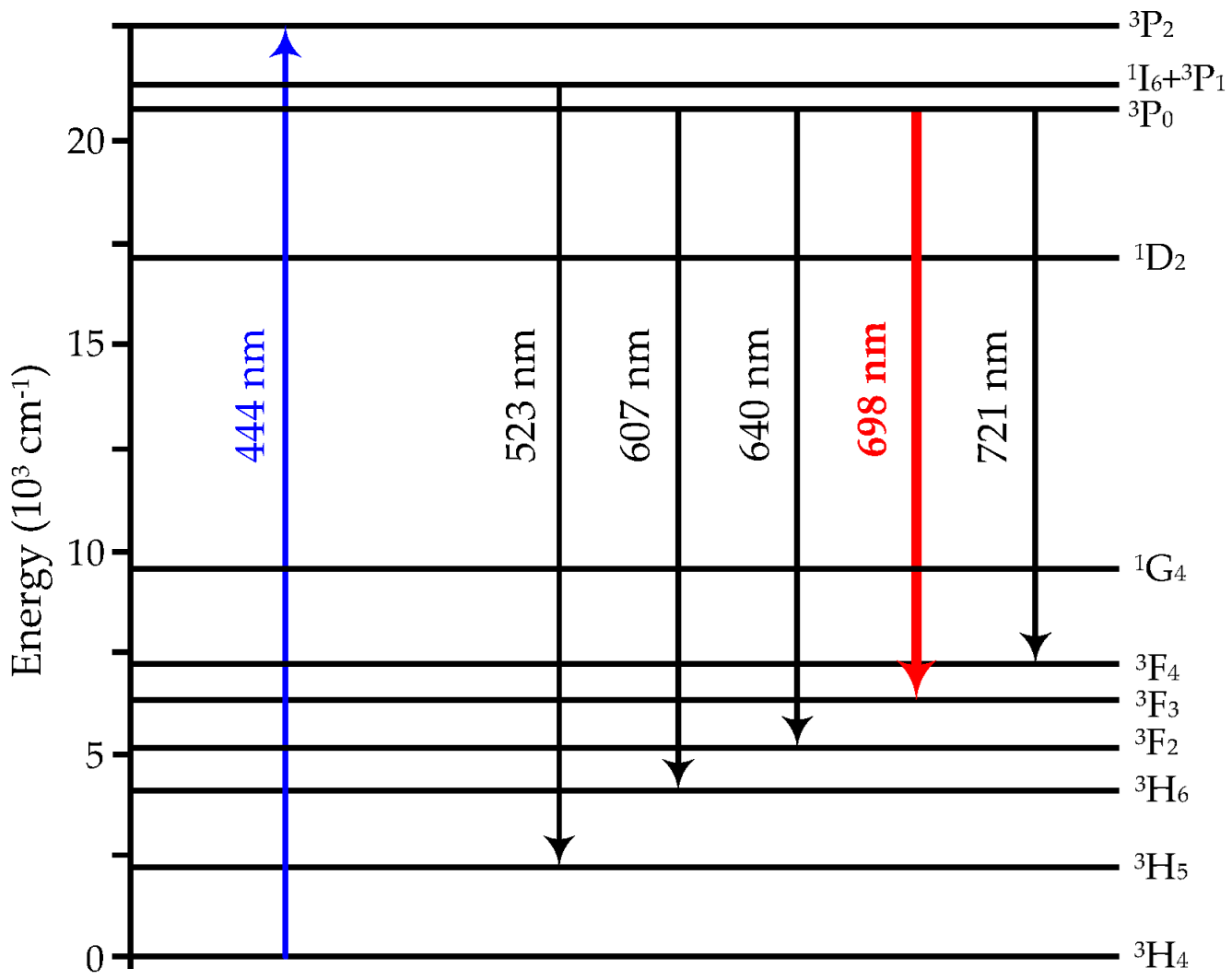

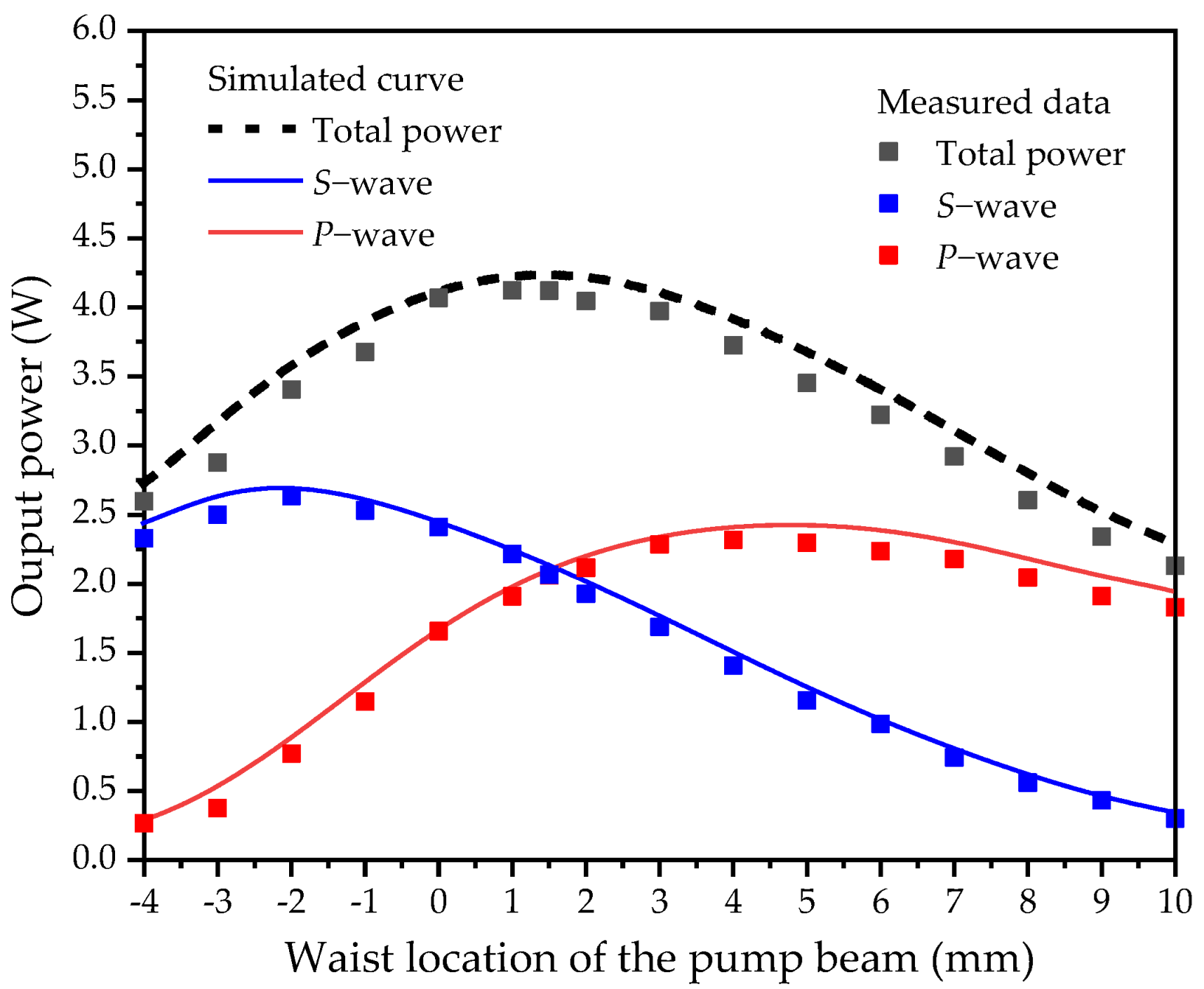
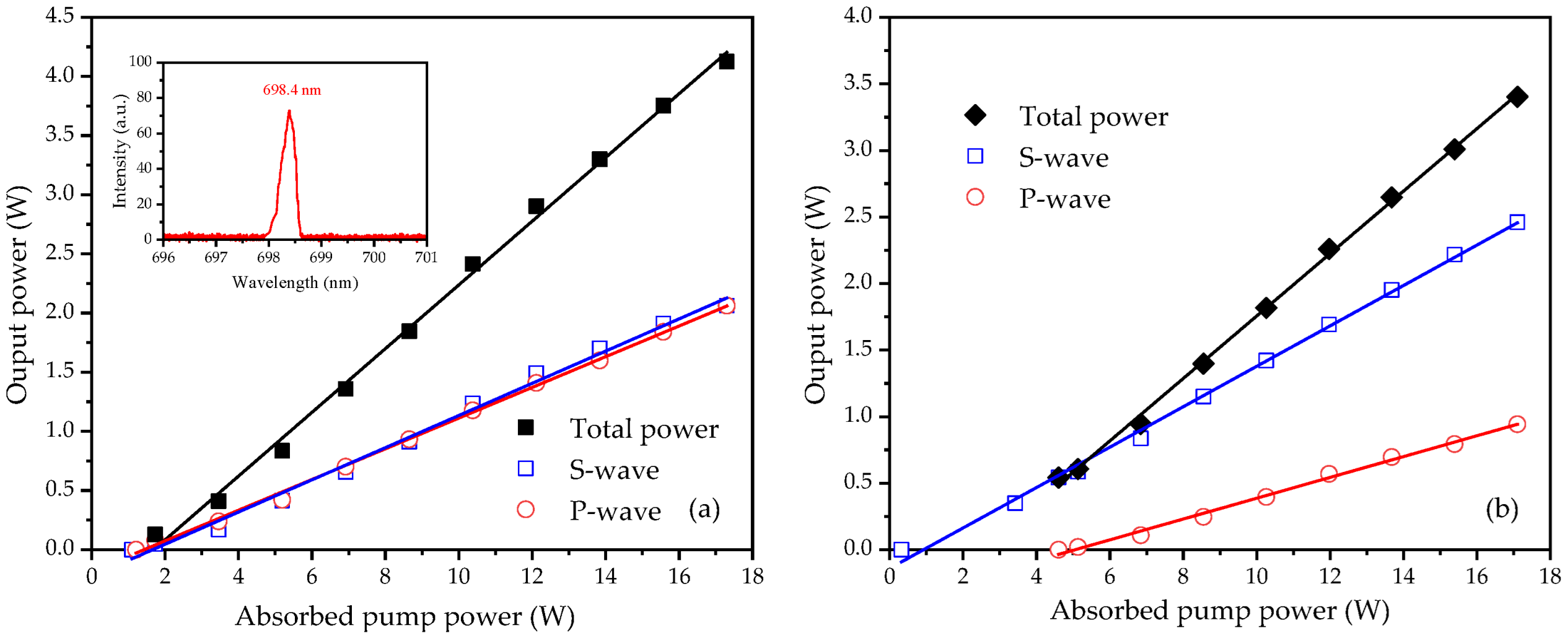

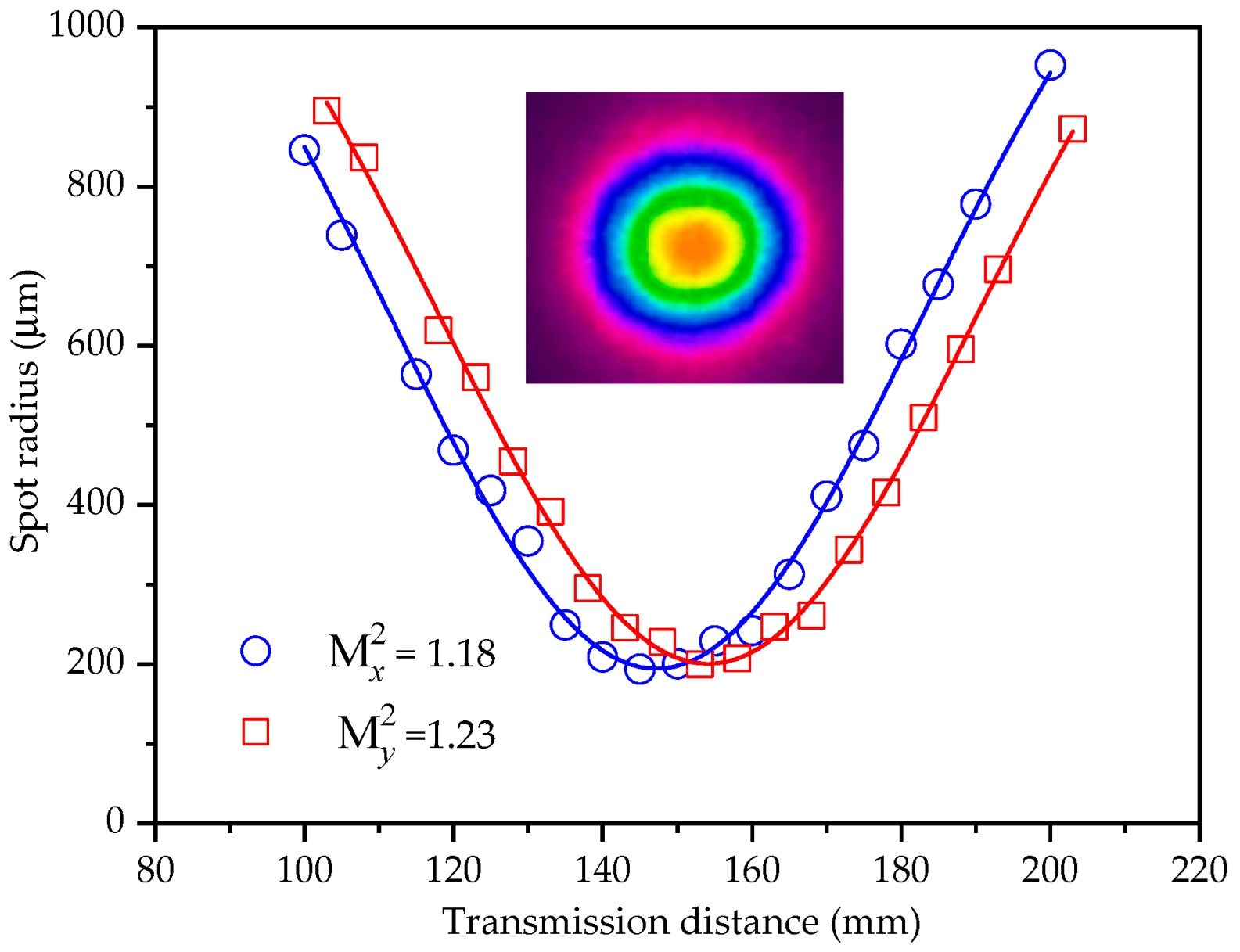

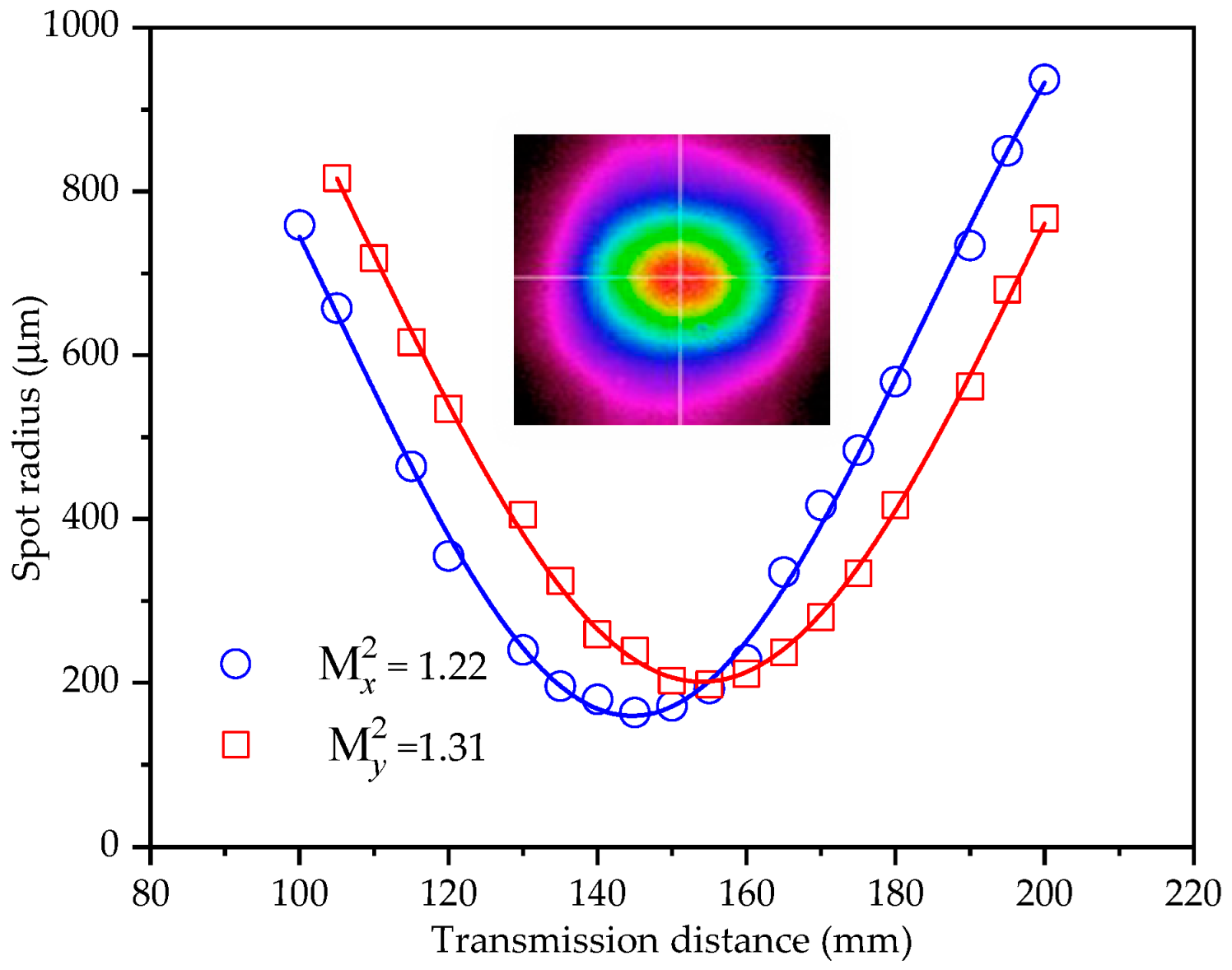
Disclaimer/Publisher’s Note: The statements, opinions and data contained in all publications are solely those of the individual author(s) and contributor(s) and not of MDPI and/or the editor(s). MDPI and/or the editor(s) disclaim responsibility for any injury to people or property resulting from any ideas, methods, instructions or products referred to in the content. |
© 2025 by the authors. Licensee MDPI, Basel, Switzerland. This article is an open access article distributed under the terms and conditions of the Creative Commons Attribution (CC BY) license (https://creativecommons.org/licenses/by/4.0/).
Share and Cite
Huang, H.; Jia, M.; Li, Y.; Xia, J.; Anh, N.; Lü, Y. Orthogonally Polarized Pr:LLF Red Laser at 698 nm with Tunable Power Ratio. Photonics 2025, 12, 666. https://doi.org/10.3390/photonics12070666
Huang H, Jia M, Li Y, Xia J, Anh N, Lü Y. Orthogonally Polarized Pr:LLF Red Laser at 698 nm with Tunable Power Ratio. Photonics. 2025; 12(7):666. https://doi.org/10.3390/photonics12070666
Chicago/Turabian StyleHuang, Haotian, Menghan Jia, Yuzhao Li, Jing Xia, Nguyentuan Anh, and Yanfei Lü. 2025. "Orthogonally Polarized Pr:LLF Red Laser at 698 nm with Tunable Power Ratio" Photonics 12, no. 7: 666. https://doi.org/10.3390/photonics12070666
APA StyleHuang, H., Jia, M., Li, Y., Xia, J., Anh, N., & Lü, Y. (2025). Orthogonally Polarized Pr:LLF Red Laser at 698 nm with Tunable Power Ratio. Photonics, 12(7), 666. https://doi.org/10.3390/photonics12070666




